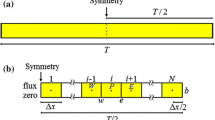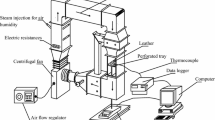Abstract
A 3D model considering heat and mass transfer for food dehydration inside a direct contact dryer is studied. The k– ε model is used to describe turbulent air flow. The samples thermophysical properties as density, specific heat, and thermal conductivity are assumed to vary non-linearly with temperature. FVM, SIMPLE algorithm based on a FORTRAN code are used. Results unsteady velocity, temperature, moisture, kinetic energy and dissipation rate for the air flow are presented, whilst temperature and moisture values for the food also are presented. The validation procedure includes a comparison with experimental and numerical temperature and moisture content results obtained from experimental data, reaching a deviation 7–10 %. In addition, this turbulent k– ε model provided a better understanding of the transport phenomenon inside the dryer and sample.







Similar content being viewed by others
Abbreviations
- C :
-
Moisture content (kg/m3)
- C 1, C 2 :
-
Constants in the turbulence model
- C p :
-
Specific heat capacity (J/kg K)
- D :
-
Mass diffusion coefficient (m2/s)
- d + c :
-
Dimensionless mixing length
- d c :
-
Distance to the wall
- g :
-
Gravity (m/s)
- G :
-
Production of kinetic turbulent energy (N/m2 s)
- h :
-
Convective heat transfer coefficient (W/m2 K)
- h :
-
Convection heat transfer coefficient (W/m2 °C)
- k :
-
Thermal conductivity (W/m K)
- K :
-
von Karman constant (0.4187)
- K m :
-
Convection mass transfer coefficient (m/s)
- l :
-
Maximum dimension in each coordinate (m)
- MR :
-
Moisture ratio (dimensionless)
- n :
-
Number of data
- p :
-
Pressure (Pa)
- Pr :
-
Prandtl number
- R :
-
Ideal gas constant (J/K mol)
- S c :
-
Independent source term
- Sc :
-
Schmidt number
- S p :
-
Dependent source term
- T :
-
Temperature (K)
- t :
-
Time (s)
- u :
-
Velocity (m/s)
- U c :
-
Tangential velocity to the wall outside of laminar sub-layer (m/s)
- U f :
-
Friction velocity on the wall (m/s)
- x, y, z :
-
Coordinates (m)
- μ :
-
Dynamic viscosity (N s/m2)
- κ :
-
Turbulent kinetic energy (m2/s2)
- ψ :
-
Porosity of food
- μ t :
-
Turbulent viscosity (N s/m2)
- d :
-
Indicator of gravity direction
- σ t :
-
Turbulent Prandtl number
- τ w :
-
Shear
- ν :
-
Kinematic laminar viscosity (m2/s)
- ε :
-
Dissipation rate of turbulent kinetic energy (m2/s2)
- ϕ :
-
Dependent variable
- α :
-
Thermal diffusivity (m2/s)
- ρ :
-
Density (kg/m3)
- ∆t :
-
Time step (s)
- ψ :
-
Porosity (dimensionless)
- o :
-
Initial conditions
- air :
-
Air properties
- eff :
-
Food effective property
- s :
-
Solid (food)
- f :
-
Fluid (air)
- i, j, k :
-
Vector direction
- num :
-
Numerical data
- exp :
-
Experimental data
- max :
-
Maximum experimental value
- min :
-
Minimum experimental value
- –:
-
Averaged value
- →:
-
Vector
- W :
-
Outer boundary of food (wall)
References
Demiray E, Tulek Y (2014) Drying characteristics of garlic (Allium sativum L.) slices in a convective hot air dryer. Heat Mass Transf 50:779–786
Demiray E, Tulek Y (2012) Thin-layer drying of tomato (Lycopersicum esculentum Mill. cv. Rio Grande) slices in a convective hot air dryer. Heat Mass Transf 48:841–847
Ozgen F (2014) Experimental investigation of drying characteristics of cornelian cherry fruits (Cornus mas L.). Heat Mass Transf 51:343–352
Chandra Mohan V, Talukdar P (2012) Design of an experimental set up for convective drying: experimental studies at different drying temperature. Heat Mass Transf 49:31–40
Xia B, Sun D-W (2002) Applications of computational fluid dynamics (CFD) in the food industry: a review. Comput Electron Agric 34:5–24
Zare D, Minaei S, Zadeh M (2006) Computer simulation of rough rice drying in a batch dryer. Energy Conver Manag 47:3241–3254
Kaya A, Aydin O, Dincer I (2006) Numerical modeling of heat and mass transfer during forced convection drying of rectangular moist objects. Int J Heat Mass Transf 49:3094–3103
Aversa M, Curcio S, Calabro V, Iorio G (2007) An analysis of the transport phenomena occurring during food drying process. J Food Eng 78:922–932
Datta A (2007) Porous media approaches to studying simultaneous heat and mass transfer in food processes I: problem formulations. J Food Eng 80:80–95
Curcio S, Aversa M, Calabro V (2008) Simulation of food drying: FEM analysis and experimental validation. J Food Eng 87:541–553
Janjai S, Lamlert N, Intawee P, Mahayothee B, Haewsungcharern M, Bala B, Muller J (2008) Finite elements simulation of drying of mango. Biosyst Eng 99:523–531
Kaya A, Aydin O, Dincer I (2008) Experimental and numerical investigation of heat and mass transfer drying of Hayward kiwi fruits (Actinidia deliciosa Planch). J Food Eng 88:323–330
Nilnont W, Thepa S, Janjai S, Kasayapanand N, Thamrongmas C, Bala B (2012) Finite elements simulation for coffee (Coffea arabica) drying. Food Bioprod Process 90:341–350
Wang L, Sun D-W (2003) Recent developments in numerical modeling of heating and cooling processes in the food industry—a review. Trends Food Sci Technol 14:408–423
Lecorvaisier E, Darche S, da Silva Z, da Silva C (2010) Theoretical model of a drying system including turbulence aspects. J Food Eng 96:365–373
Sabarez H (2012) Computational modelling of the transport phenomena occurring during convective drying of prunes. J Food Eng 111:279–288
Chr Lamnatou, Papanicolaou E, Belessiotis V, Kyriakis N (2009) Conjugate heat and mass transfer from a drying rectangular cylinder in confined air flow. Numer Heat Transf Part A 56:379–405
Lemus-Mondaca R, Vega-Gálvez A, Moraga N (2011) Computational simulation and developments applied to food thermal processing. Food Eng Rev 3:121–135
Hussain M, Dincer I (2003) Numerical simulation of two-dimensional heat and moisture transfer during drying of a rectangular object. Numer Heat Transf Part A 43:867–878
Oztop H, Kavak A (2008) Numerical and experimental analysis of moisture transfer for convective drying of some products. Int Comm Heat Mass Transf 35:169–177
Villa-Corrales L, Flores J, Xamán J, García E (2010) Numerical and experimental analysis of heat and moisture transfer during drying of Ataulfo mango. J Food Eng 98:198–206
Moraga N, Jauriat L, Lemus-Mondaca R (2012) Heat and mass transfer in conjugated food freezing/air natural convection. Int J Refrig 35:880–889
Zambra C, Moraga N, Rosales C, Lictevouta C (2012) Unsteady 3D heat and mass transfer diffusion coupled with turbulent forced convection for compost piles with chemical and biological reactions. Int J Heat Mass Transf 55:6695–6704
Davidson P (2000) Turbulence. Oxford University Press, Oxford
Launder B, Spalding D (1974) The numerical computation of turbulent flows. Comput Methods Appl Mech Eng 3:269–289
Tsilingiris P (2008) Thermophysical and transport properties of humid air at temperature range between 0 and 100 °C. Energy Conver Manag 49:1098–1110
Lemus-Mondaca R, Betoret N, Vega-Galvéz A, Lara E (2009) Dehydration characteristics of papaya (Carica pubenscens): determination of equilibrium moisture content and diffusion coefficient. J Food Process Eng 32:645–663
AOAC (1990) Official method of analysis, methods 934.06 and 942.15 A. Association of Official Analytical Chemists, Arlington, VA
Coimbra J, Gabas A, Minim L, Rojas E, Telis V, Telis-Romero J (2006) Density, heat capacity and thermal conductivity of liquid egg products. J Food Eng 74:186–190
Krokida M, Maroulis Z (2000) Quality changes during drying of foods materials. In: Mujumdar AS (ed) Drying technology in agricultural and food sciences. Science Publishers, Endfield, pp 61–106
Zanoelo E, Benincá V, Ribeiro E (2011) Thermophysical properties of mate leaves: experimental determination and theoretical effect of moisture content. J Food Process Eng 34:2124–2136
Versteeg H, Malalasekera W (1995) An introduction to computational fluid dynamics: the finite, vol method. Longman Scientific Technical Press, Addison Wesley Longman Ltd, London
Patankar S (1980) Numerical heat transfer and fluid flow. Hemisphere, Washington
Kurozawa L, Park K, Azonbel P (2008) Thermal conductivity and thermal diffusivity of papaya (Carica papaya L.) and Cashew apple (Anacardium occidentale L.). Braz J Food Technol 11:78–85
Ikegwu O, Ekwu F (2009) Thermal and physical properties of some tropical fruits and their juices in Nigeria. J Food Technol 7:38–42
Lemus-Mondaca R, Zambra C, Vega-Gálvez A, Moraga N (2013) Coupled 3D heat and mass transfer model for numerical analysis of drying process in papaya slices. J Food Eng 116:109–117
Smolka J, Nowak A, Rybarz D (2010) Improved 3-D temperature uniformity in a laboratory drying oven based on experimentally validated CFD computations. J Food Eng 97:373–383
Amanlou Y, Zomorodian A (2010) Applying CFD for designing a new fruit cabinet dryer. J Food Eng 101:8–15
Kaya A, Aydın O, Dincer I (2007) Heat and mass transfer modeling of recirculating flows during air drying of moist objects for various dryer configurations. Numer Heat Transf Part A 53:18–34
Acknowledgments
The authors gratefully acknowledge to FONDECYT no. 1140074 Project and DIULS Multidisciplinar PMU13331 Project for providing financial support for the publication of this research.
Author information
Authors and Affiliations
Corresponding author
Rights and permissions
About this article
Cite this article
Lemus-Mondaca, R.A., Vega-Gálvez, A., Zambra, C.E. et al. Modeling 3D conjugate heat and mass transfer for turbulent air drying of Chilean papaya in a direct contact dryer. Heat Mass Transfer 53, 11–24 (2017). https://doi.org/10.1007/s00231-016-1799-0
Received:
Accepted:
Published:
Issue Date:
DOI: https://doi.org/10.1007/s00231-016-1799-0




